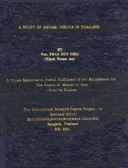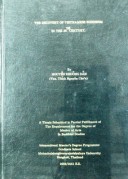Tìm Sách
Luận Văn - Thesis - Tiểu Luận >> A study Annam Nikaya in Thailand
Thông tin tra cứu
- Tên sách : A study Annam Nikaya in Thailand
- Tác giả : Ven. Thích Nhuận An
- Dịch giả :
- Ngôn ngữ : Anh
- Số trang : 136
- Nhà xuất bản : Thesis MA ThaiLand
- Năm xuất bản : 2008
- Phân loại : Luận Văn - Thesis - Tiểu Luận
- MCB : 1210000009423
- OPAC :
- Tóm tắt :
A STUDY OF ANNAM – NIKAYA IN THAILAND
By Ven . TRAN DUY HIEU
(Thích Nhuan An)
A Thesis Submitted in Partial Fulfillment of the Requirement for
The Degree of Master of Arts
(Buddhist Studies)
The International Master’s Degree Programme
Graduate School
MahachulalongkornrajavidyalayaUniversity
Bangkok , Thailand
B. E. 2551
TABLE OF CONTENTS
Approval Page
Abstract
Acknowledgements
List of Abbreviations
Table of Contents
Chapter 1 : Introduction
1.1 Background and Significance of the Study
1.2 Objectives of Research
1.3 Research Questions
1.4 Expected Benefits of Study
1.5 Scope of the Research
1.6 Definitions of the Terms used in the Thesis
1.7 Methods of Study
1.8 Documents and Research Works concerned
Chapter 2 : The History of Annam – Nikaya in Thailand
2.1 Origin of Annam – Nikaya
2.1.1 The migratory waves of Vietnamese to Thailand
2.1.1.1 During the Ayutthaya period
2.1.1.2During the early Rattanakosin
2.1.1.3 During the period of King Rama The Third, the Fourth, and the Fifth
2.1.1.4 During and after the Second World War
2.1.2 Forming of Vietnamese communities
2.1.2.1 During Ayutthaya period
2.1.2.2 During the early Rattanakosin period
2.1.2.3 During the period of King Rama the Third, the Fourth, and the Fifth
2.1.2.4 During and after the WWII period
2.2 The Process of Formation and Development of Annam – Nikaya
2.2.1 The Period of Formation
2.2.2 The period of Development
2.2.2.1 First stage – During the reign of King Rama the Third, and the Fourth
2.2.2.2 Second stage – From King Rama the Fifth to the end of WWII
2.2.3 The period of Difficulty
2.2.4 The Period of Stability
Chapter 3 : Characteristics of Annam – Nikaya in Thailand
3.1 Great Influence of the Vietnamese southern Culture
3.1.1 Daily appellation
3.1.2 Chanting accent
3.1.3 Trađitional rituals
3.2 A Harmonious Adaptation to Thai Buddhist Tradition
3.2.1 Ecclesiastic order
3.2.2 Monastic robes
3.2.3 Monastic tradition activities
3.3 A Mutual Unification of Both Lâm Tế and Tào Động Zen schools
3.3.1 Lâm Tế (Lin-Chi) Zen School
3.3.2 Tào Động (Ts’ao-Tung) Zen school
3.3.3 Naming of Annam-Nikaya monks
3.3.4 The mental training approach
3.4 The Remaining of Two Zen Master’Relics
3.4.1 Zen Master Thích Hổ Phách’s Relics
3.4.2 Zen Master Thích Phổ Sái’s Relics
Chapter 4 : The Present Status of Annam – Nikaya in Thailand
4.1 Monks and Temples
4.2 Monk’s education
4.3 Daily practices
4.4 Dharma propagation
4.5 Taking part in rituals
4.6 Dealings with lay Buddhists
4.7 Annual festivals
Chapter 5 : Conclusion and Suggestions
5.1 Conclusion
5.2 Suggestions for future studies
Bibliography
Appendix 1. Som illustrative photographs of Annam – Nikaya
2. List of Annam – Nikaya temple addresse in Thailand
3. Questionnaire for Annam – Nikaya Monks
4. Questionnaire for Annam – Nikaya temple’s attendants
Biography
 Facebook
Facebook
 Google
Google
 Google+
Google+











